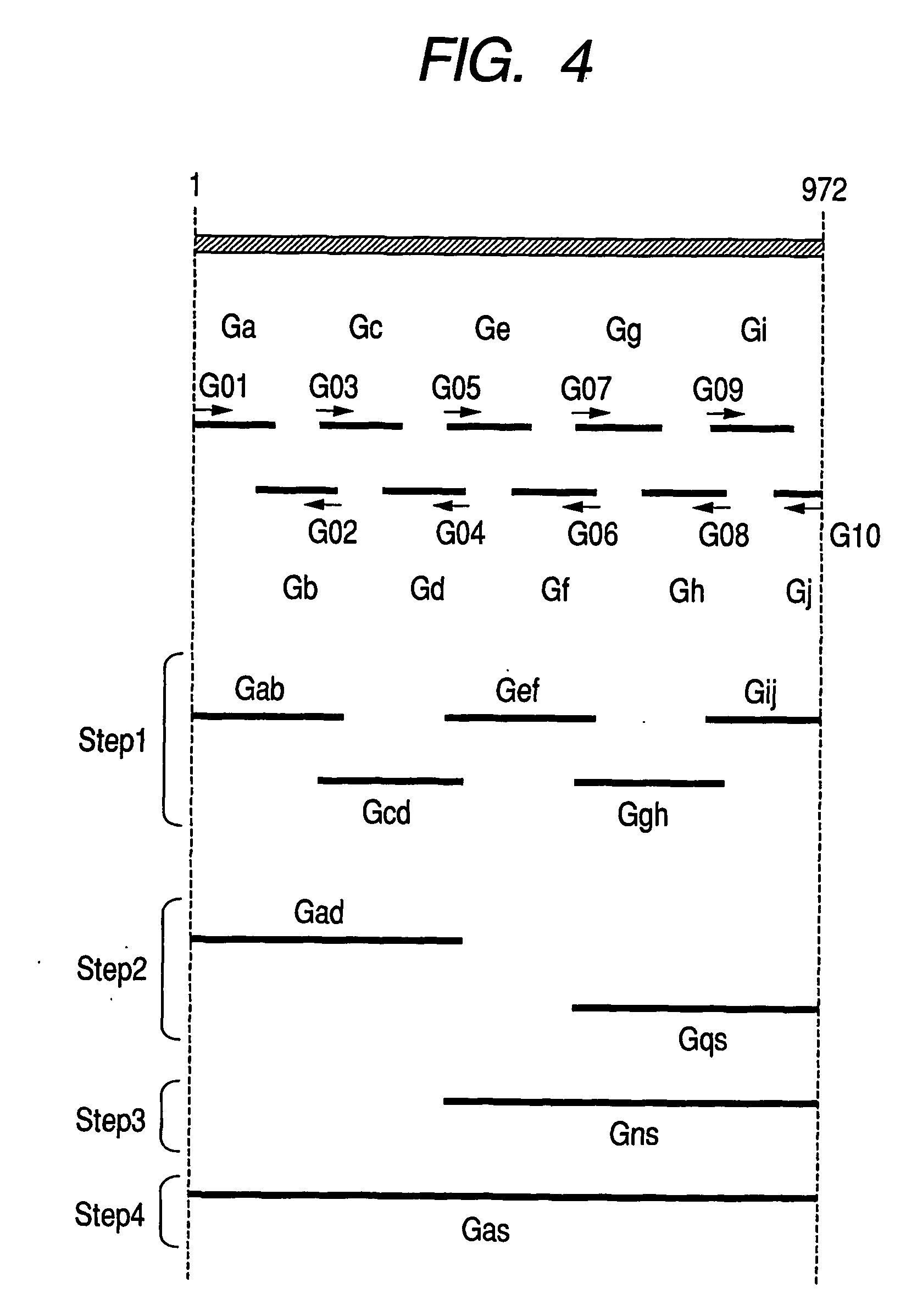Kit for Immobilizing Organic Substance, Organic Substance-Immobilized Structure, and Manufacturing Methods Therefor
- Summary
- Abstract
- Description
- Claims
- Application Information
AI Technical Summary
Benefits of technology
Problems solved by technology
Method used
Image
Examples
reference example 1
[0146]A transformant having an ability to produce a PHA synthetic enzyme and a transformant having an ability to produce a PHA synthetic enzyme by production of the PHA synthetic enzyme with recombination were manufactured by the following methods:
[0147]At first, strain YN2 (Pseudomonas cichorii YN2, FERM BP-7375) having an ability to produce a PHA synthetic enzyme was incubated overnight at 30° C. in 100 ml of an LB medium (1% polypepton, 0.5% yeast extract, and 0.5% sodium chloride, pH 7.4), and then chromosomal DNA of the strain YN2 was isolated and collected by the method of Manner et al. The chromosomal DNA thus obtained was completely digested with the restriction enzyme HindIII. A cloning vector used was pUC18 and cleaved by the restriction enzyme HindIII. The end of the product was subjected to a dephosphorization process (Molecular Cloning, 1, 572 (1989); Cold Spring Harbor Laboratory Press), and then a chromosomal DNA fragment completely digested with HindIII was coupled a...
example 1
Procurement of Amino Acid Sequence Having Affinity to Aluminum Oxide Nanoholes
1) Selection of Aluminum Oxide Affinity Phage by Panning Technique
(Step 1)
[0184]With 0.1% Tween-20 / TBS buffer (50 mM tris-HCl, pH 7.5, 150 mM NaCl (hereinafter, referred as to TBST buffer)), 2×1011 pfu of the PhD.-12 phage display peptide library (NEW ENGLAND BIOLAB) was diluted to 0.5 ml to obtain a library suspension.
(Step 2)
[0185]For procurement of the amino acid sequence, 0.5 ml of the above library suspension was added into one well of a flat-bottomed 24-well titer plate in which one aluminum oxide membrane (60 μm in thickness, 13 mm in diameter, pore size 0.2 μm, trade name: Anodisc Membrane, manufactured by Whatman) was placed, and left to stand at 25° C. for 30 minutes.
(Step 3)
[0186]The supernatant was discarded and the Anodisc Membrane was washed ten times with 2 ml of TBST buffer within the above well.
(Step 4)
[0187]After 0.5 ml of elution buffer (0.2M Glycine-HCl (pH 2.2), 1 mg / ml BSA) was added ...
example 2
Procurement of Cyclic Amino Acid Sequence Having Affinity to Aluminum Oxide
1) Selection of Aluminum Oxide Affinity Phage by Panning Technique
(Step 1)
[0205]With 0.1% Tween-20 / TBS buffer (50 mM tris-HCl, pH 7.5, 150 mM NaCl (hereinafter, referred as to TBST buffer)), 2×1011 pfu of the PhD.-C7C phage display peptide library (NEW ENGLAND BIOLAB) was diluted to 0.5 ml to obtain a library suspension.
(Step 2)
[0206]For procurement of the amino acid sequence, 0.5 ml of the library suspension was added into one well of a flat-bottomed 24-well titer plate in which one aluminum oxide membrane (60 μm in thickness, 13 mm in diameter, pore size 0.2 μm, Anodisc Membrane, manufactured by Whatman) was placed, and left to stand at 25° C. for 30 minutes.
(Step 3)
[0207]The supernatant was discarded and the Anodisc Membrane was washed ten times with 2 ml of TBST buffer within the above well.
(Step 4)
[0208]After 0.5 ml of elution buffer (0.2M Glycine-HCl (pH 2.2), 1 mg / ml BSA) was added to the Anodisc Membr...
PUM
| Property | Measurement | Unit |
|---|---|---|
| Fraction | aaaaa | aaaaa |
| Volume | aaaaa | aaaaa |
| Length | aaaaa | aaaaa |
Abstract
Description
Claims
Application Information
 Login to View More
Login to View More - R&D
- Intellectual Property
- Life Sciences
- Materials
- Tech Scout
- Unparalleled Data Quality
- Higher Quality Content
- 60% Fewer Hallucinations
Browse by: Latest US Patents, China's latest patents, Technical Efficacy Thesaurus, Application Domain, Technology Topic, Popular Technical Reports.
© 2025 PatSnap. All rights reserved.Legal|Privacy policy|Modern Slavery Act Transparency Statement|Sitemap|About US| Contact US: help@patsnap.com



